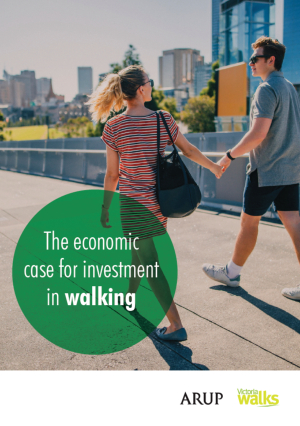Walk away from traffic congestion
13 Dec 2018
New research from global consultancy firm Arup has found strong investment in walking could replace 2.4 million car trips each week in Melbourne and Geelong.
The Economic Case for Investment in Walking, commissioned by Victoria Walks, outlines the benefits of walking, along with the role it plays in transport, recreation and health. The report then analyses how government investment frameworks apply to walking.
The report found that if half of short private vehicle trips (0-0.9 km) were converted to walking, there would be 2.4 million fewer vehicle trips each week, with savings of $165 million each year.
“Real congestion-busting is getting cars off the road,” says Victoria Walks Executive Officer, Ben Rossiter. “What governments have been doing over decades, building more freeways, is not working. Congestion is getting worse and Victorians are getting fat and unhealthy.”
Walking accounts for 1 in 6 of Melbourne’s weekday trips and is the most popular recreational activity, with over one million participants in Victoria. But the report describes it as ‘the invisible transport mode’ – poorly covered in the census and often lumped together with cycling as ‘active transport.’
“Walking is an indicator of a city’s liveability, vibrancy and health, yet it is typically overlooked in planning and investment decisions, using somewhat outdated economic assessment methodology,” said Arup’s Dr Francesca Maclean.
The research found investing in walking infrastructure can provide a higher economic return than other transport projects such as rail and road. Evidence from 20 different studies suggested that the benefit cost ratio of walking interventions is 13:1 – $13 of benefit for every $1 of expenditure. Arup found the potential benefits of walking have not resulted in investment in Victoria.
“The current process used to assess the economic merit of walking makes it very difficult to justify walking projects such as installing or upgrading a pedestrian crossing or footpath” said Dr Maclean.
“Walking has been overlooked as a potential investment and underplayed in city-shaping projects,” she added. “Most train trips start and end with walking, but the economic evaluation for projects such as Melbourne Metro have not included walking.”
“A third of people who drive to Melbourne’s train stations live within 800 metres,” said Dr Rossiter. “Projects like level crossing removals should include investing in safe, convenient walking routes to the stations from a 1.5km radius. If we invested in walking, carparks would be freed up for people who really needed them.”
“A big challenge for walking is it cuts across many local, state and federal government agencies, so no-one takes the lead and it tends to fall through the cracks of policy and investment,” said Dr Rossiter.
Recommendations to the state government from The Economic Case for Investment in Walking include:
- Increase investment in walking projects through a dedicated funding stream. It suggests a transition to 20% of the State transport budget being spent on non-motorised transport, as per UN recommendations
- Establish a clear governance group responsible for the strategy, planning, investment, and reporting of walking projects
- Develop a clear strategy and associated action plan for walking in Victoria
- Clearly delineate investment in walking in both budgeting and annual reporting
- Collect better data on walking both as a transport mode by itself and as a crucial element of multi-modal trips.
“The new government’s election promises on walking for transport were encouraging, but there’s no funding committed as yet,” Dr Rossiter says. “We need a strong plan to set the agenda for action.”
“Global cities like London have strong walking strategies and closer to home Queensland is developing a walking strategy. Victoria is behind the game,” Dr Rossiter said.
Note, the statistic “A third of people who drive to Melbourne’s train stations live within 800 metres” comes from the Change to Walking 2017-18 program and outcomes report.